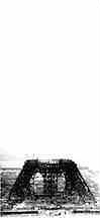

To build the Eiffel Tower, Gustave Eiffel
used very particular techniques, which were his own.
I / piles and pillars The building of the Eiffel Tower began in January 27th, 1887. About 280 people worked at the rising of the tower; they began by building pillars; they injected concrete under pressure into waterproof forms. Thanks to compressed air some very hard stones were used to form the base. On the banks of the Seine, Eiffel used waterproof metal boxes in which the workers were able to work under the water level. After the completion of pillars, workers began the building of piles: they were the four" legs" of the tower. They joined at the second floor, 115.73 meters above ground, to make only one pillar from the second to the third floor.
|
|
II/The techniques
of assembling of beams To join beams, workers used a new process designed by Eiffel. It consisted in joining the metal beams in three steps: the brooch which allowed to loosen the structure ,bolts which were used only serves to maintain beams together without leaving any play and were then replaced by the definitive rivets. Rivets were heated to white-hot on a small heater, then introduced into the prepared holes;the heads of the rivets were crushed while the metal was moldable to immobilize them. The Eiffel Tower was in fact built exactly like a huge meccano.
|
|
III/ Jacks and scaffolds When the workers wanted to assemble the first floor, they noticed that several centimeters were missing. Eiffel used then two 800-ton hydraulic jacks, which he placed under pillars to lift them and to correct adjusting flaws. But Eiffel also used another technique. It consisted in placing bags filled with sand between some beams to be used as adjustable holds. Beams rose slightly above their definitive place, then were adjusted into their final position by progressive drainage of the sand, and finally fixed. Before assembling the first floor, Eiffel had to make specifically fitted scaffolds. First of all he settled four of them to support every pillar. As building went on, he made them higher. Another 50 meters high wooden scaffold was erected in the center of the tower to support the first floor.
|
IV/ The Eiffel Tower’s catching wind To build his Tower, Eiffel implemented a new technique, which had never been used before to make towers able to hold the wind. Indeed, Eiffel built his tower in an exponential way: it started with a very wide base and ended in a summit, which reduced the surface of contact between the tower and the wind. Moreover, the beams were made in such a way as the wind was pushed onto the sides of every beam. Eiffel having built his tower only with metallic beams, the wind gets through the tower and contact areas are limited. It does not prevent the tower from moving up to six centimeters when the wind blows.
|
V/ Decoration For World Fairs of 1889, Eiffel wanted the tower to be decorated, then he had the bow laid under the first floor of the tower, they were supported by the beams of the first floor and served only as decoration. To keep the Eiffel Tower from rusting, it had to be repainted regularly. Seven years were needed to paint it completely and when the work was finished, the painters had to begin again and they had to begin where they had started seven years before. So that the Eiffel Tower looks painted in the same color to us, it is painted in several different colors. The base is painted in a very dark color, a brown with hints of red, the color gets lighter up to the summit to end in a yellow at the top of the dome.
|